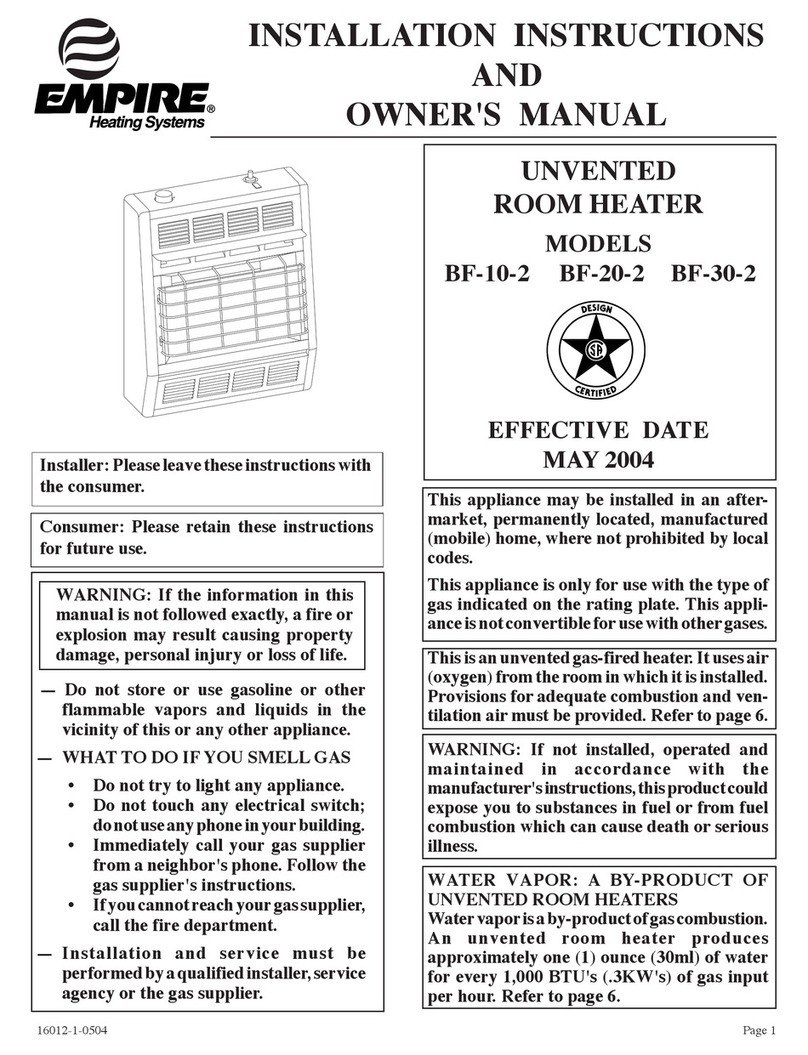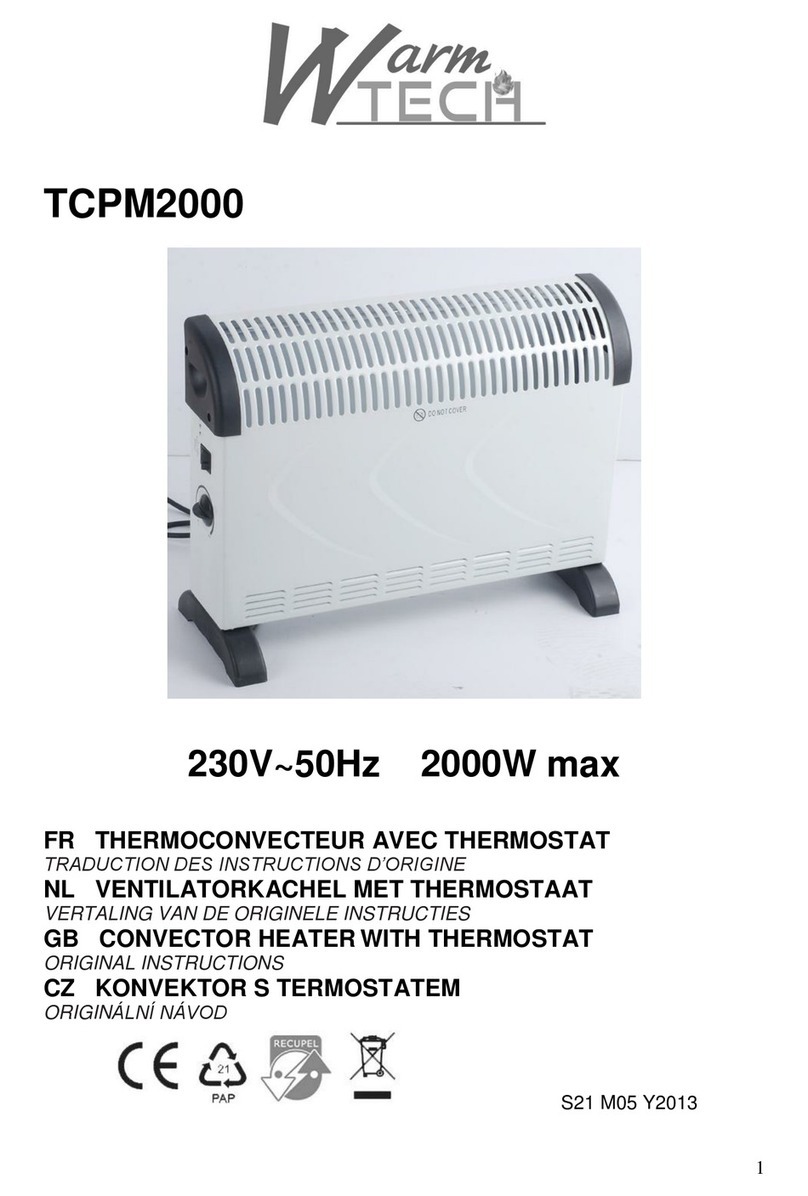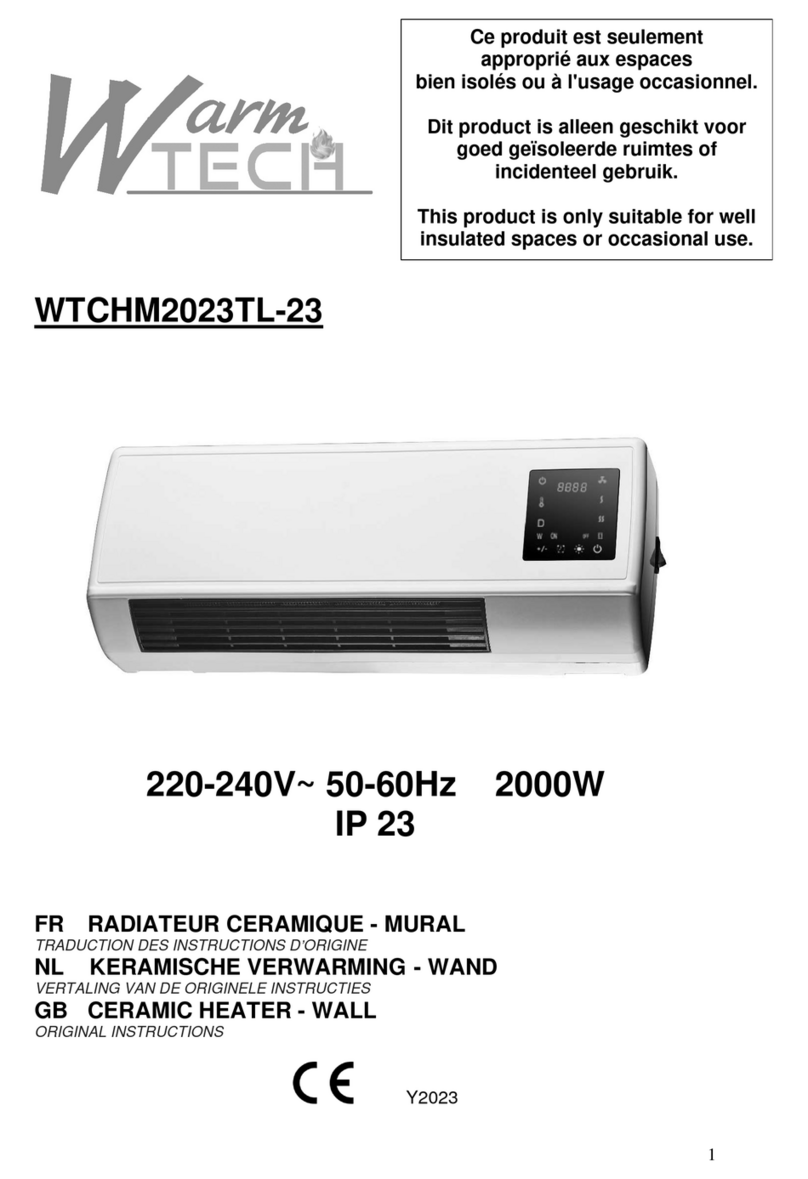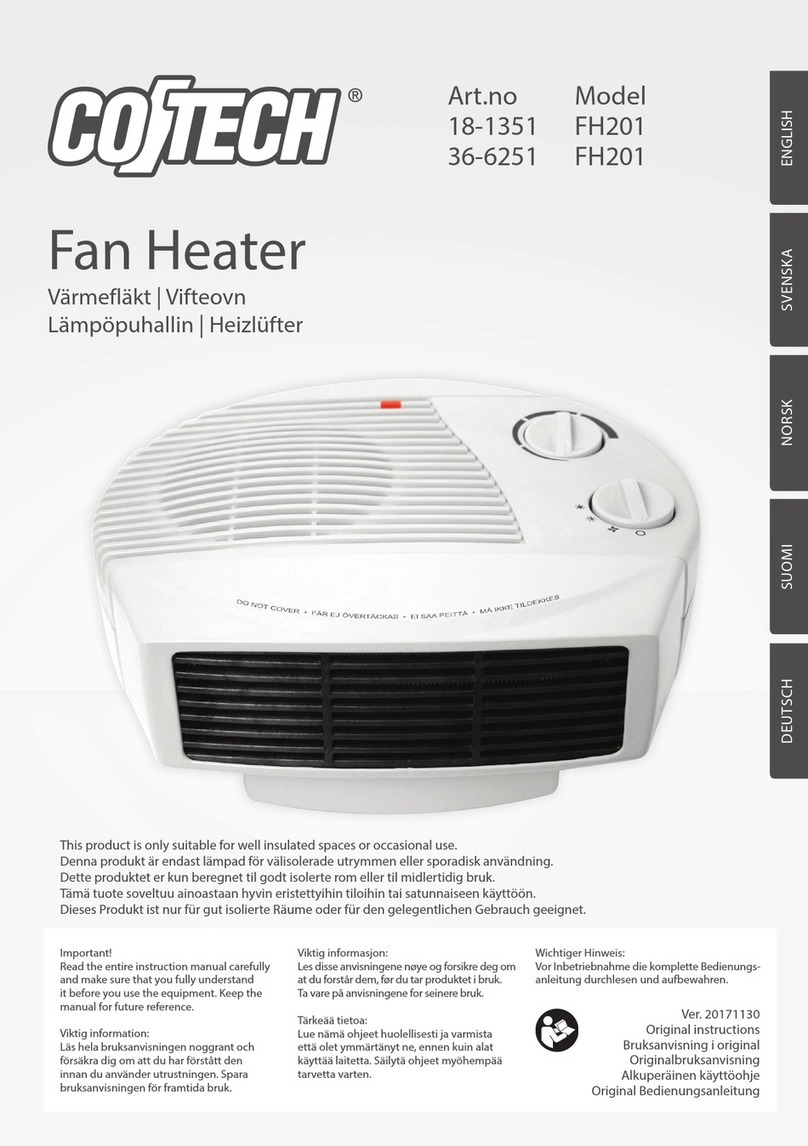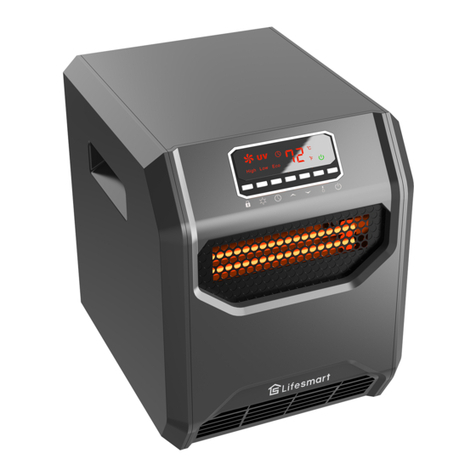Empire Products RH-25-6 Quick start guide

Page 112821-2-0903
VENTED
ROOM HEATER
MODELS
RH-25-6
RH-35-6
EFFECTIVE DATE
SEPTEMBER 2003
INSTALLATION INSTRUCTIONS
AND
OWNER’S MANUAL
WARNING: If the information in
this manual is not followed exactly, a
fire or explosion may result causing
property damage, personal injury or
loss of life.
— Do not store or use gasoline or other
flammable vapors and liquids in the
vicinityofthisoranyotherappliance.
— WHATTODOIFYOUSMELLGAS
•Do not try to light any appliance.
•Donottouchanyelectricalswitch;
donotuseanyphoneinyourbuild-
ing.
•Immediatelycallyourgassupplier
from a neighbor’s phone. Follow
the gas supplier’s instructions.
•If you cannot reach your gas sup-
plier, call the fire department.
— Installation and service must be per-
formedbyaqualifiedinstaller,service
agency or the gas supplier.
WARNING: If not installed, operated
and maintained in accordance with the
manufacturer’sinstructions, this prod-
uct could expose you to substances in
fuel orfrom fuel combustion which can
cause death or serious illness.
Installer: Please leave these instructions
with the consumer.
Consumer:Pleaseretaintheseinstructions
for future use.

Page 2 12821-2-0903
SECTION PAGE
Important Safety Information ..................................................................................................................... 3
Safety Information for Users of LP Gas..................................................................................................... 4
Introduction ................................................................................................................................................ 5
Specifications ............................................................................................................................................. 5
Gas Supply.................................................................................................................................................. 6
Clearances................................................................................................................................................... 7
Venting ....................................................................................................................................................... 7
Vent Safety Shutoff System ....................................................................................................................... 8
Reversible Vertical or Horizontal Diverter ................................................................................................ 8
Thermostat Operation ................................................................................................................................. 8
Lighting Instructions .................................................................................................................................. 9
Pilot Flame Characteristics....................................................................................................................... 10
Main Burner Flame Characteristics.......................................................................................................... 10
Maintenance.............................................................................................................................................. 11
Troubleshooting........................................................................................................................................ 11
How to Order Repair Parts ....................................................................................................................... 12
Parts List ................................................................................................................................................... 12
Parts View ................................................................................................................................................ 13
Optional Blower Installation Instructions............................................................................................14-15
Service Notes............................................................................................................................................ 16
TABLE OF CONTENTS

Page 312821-2-0903
• Due to high temperatures, the room heater should be
located out of traffic and away from furniture and drap-
eries.
• Children and adults should be alerted to the hazards of
high surface temperature and should stay away to avoid
burns or clothing ignition.
• Youngchildrenshouldbecarefullysupervisedwhenthey
are in the same room as the room heater.
• Clothingorotherflammablematerialshouldnotbeplaced
on or near the room heater.
• Duetohighsurfacetemperatures,keepchildren,clothing
and furniture away.
• Keep burner and control compartment clean.
• Installation and repair should be done by a QUALIFIED
SERVICE PERSON. The room heater should be in-
spected before use and at least annually by a qualified
service person. More frequent cleaning may be required
due to excessive lint from carpeting, bedding material,
etc. It is imperative that control compartments, burners
and circulating air passageways of the room heater be
kept clean.
• DO NOT put anything around the heater that will ob-
struct the flow of combustion and ventilation air. See
clearances.
• DO keep the appliance area clear and free from combus-
tible material, gasoline and other flammable vapors and
liquids.
• DO examine venting system periodically. Clean and
replacedamaged parts. Examinationsshould bemadeat
the start of the heating season and also in mid heating
season under average conditions.
• DO examine burners periodically. Clean and replace
damaged parts.
• DONOTusethisheaterifanyparthasbeenunderwater.
Immediately call a qualified service technician to inspect
the heater and to replace any part of the control system
and any gas control which has been under water.
THIS IS A HEATING APPLIANCE
DO NOT OPERATE THIS APPLIANCE WITHOUT FRONT PANEL INSTALLED.
IMPORTANT SAFETY INFORMATION
Attention: During operation of vented room heater the gasket for observation hole cover, observation hole cover and cover plate
for observation hole cover must be attached to combustion chamber and secured with two (2) wing nuts.

Page 4 12821-2-0903
Somepeoplecannotsmellwell.Somepeoplecannotsmellthe
odorofthechemicalputintothegas.Youmustfindoutifyou
cansmelltheodorant inpropane.Smoking candecreaseyour
ability to smell. Being around an odor for a time can affect your
sensitivity or ability to detect that odor. Sometimes other odors
inthe area maskthe gasodor.Peoplemay notsmell thegas odor
or their minds are on something else. Thinking about smelling a
gas odor can make it easier to smell.
The odorant in LP-gas is colorless, and it can fade under
some circumstances. For example, if there is an underground
leak,themovementofthe gas through soil can filter theodorant.
OdorantsinLP-Gasalsoaresubjecttooxidation.Thisfadingcan
by point with the members of your household. Someday
whentheremaynotbeaminutetolose,everyone'ssafetywill
depend on knowing exactly what to do. If, after reading the
followinginformation, youfeel youstill needmore informa-
tion, please contact your gas supplier.
Propane (LP-Gas) is a flammable gas which can cause fires
and explosions. In its natural state, propane is odorless and
colorless.Youmaynot knowallthefollowingsafety precau-
tions which can protect both you and your family from an
accident. Read them carefully now, then review them point
occur if there is rust inside the storage tank or in iron gas pipes.
The odorant in escaped gas can adsorb or absorb onto or into
walls, masonry and other materials and fabrics in a room. That
will take some of the odorant out of the gas, reducing its odor
intensity.
LP-Gasmaystratifyinaclosedarea,andtheodorintensitycould
vary at different levels. Since it is heavier than air, there may be
more odor at lower levels. Always be sensitive to the slightest
gas odor. If you detect any odor, treat it as a serious leak.
Immediately go into action as instructed earlier.
•Learnto recognizetheodor ofLP-gas. Yourlocal LP-Gas
Dealercangive youa"ScratchandSniff"pamphlet.Useit to
findoutwhatthepropaneodorsmellslike.Ifyoususpectthat
yourLP-Gas hasa weak orabnormal odor, callyour LP-Gas
Dealer.
• If you are not qualified, do not light pilot lights, perform
service, or make adjustments to appliances on the LP-Gas
system.Ifyouarequalified,consciouslythinkabouttheodor
ofLP-Gas priorto andwhilelighting pilotlights orperform-
ing service or making adjustments.
• Sometimes a basement or a closed-up house has a musty
smell that can cover up the LP-Gas odor. Do not try to light
pilot lights, perform service, or make adjustments in an area
where the conditions are such that you may not detect the
odor if there has been a leak of LP-Gas.
• Odor fade, due to oxidation by rust or adsorption on walls of
new cylinders and tanks, is possible. Therefore, people
should be particularly alert and careful when new tanks or
cylinders are placed in service. Odor fade can occur in new
tanks, or reinstalled old tanks, if they are filled and allowed
to set too long before refilling. Cylinders and tanks which
have been out of service for a time may develop internal rust
which will cause odor fade. If such conditions are suspected
to exist, a periodic sniff test of the gas is advisable. If you
have any question about the gas odor, call your LP-gas
dealer. A periodic sniff test of the LP-gas is a good safety
measure under any condition.
• If, at any time, you do not smell the LP-Gas odorant and you
thinkyoushould,assumeyouhavealeak.Thentakethesame
immediateactionrecommendedabovefortheoccasionwhen
you do detect the odorized LP-Gas.
• If you experience a complete "gas out," (the container is
under no vapor pressure), turn the tank valve off immedi-
ately.Ifthecontainervalveislefton,thecontainermaydraw
in some air through openings such as pilot light orifices. If
this occurs, some new internal rusting could occur. If the
valve is left open, then treat the container as a new tank.
Always be sure your container is under vapor pressure by
turningitoffatthecontainerbeforeitgoescompletelyempty
or having it refilled before it is completely empty.
• Do not operate electric switches, light matches, use your
phone. Do not do anything that could ignite the gas.
• Geteveryoneout ofthebuilding,vehicle,trailer,orarea.Do
that IMMEDIATELY.
• Close all gas tank or cylinder supply valves.
• LP-Gas is heavier than air and may settle in low areas such
as basements. When you have reason to suspect a gas leak,
keep out of basements and other low areas. Stay out until
firefighters declare them to be safe.
• Useyour neighbor'sphoneandcallatrainedLP-Gasservice
person and the fire department. Even though you may not
continuetosmellgas,donotturnonthegasagain.Donotre-
enter the building, vehicle, trailer, or area.
•Finally, let the service man and firefighters check for
escaped gas. Have them air out the area before you return.
Properly trained LP-Gas service people should repair the
leak, then check and relight the gas appliance for you.
SOME POINTS TO REMEMBER
NO ODOR DETECTED - ODOR FADE
LP-GAS WARNING ODOR
If a gas leak happens, you should be able to smell the gas because of the odorant put in the LP-Gas.
That's your signal to go into immediate action!
SAFETY INFORMATION FOR USERS OF LP-GAS

Page 512821-2-0903
INTRODUCTION
Introduction
Always consult your local Building Department regarding
regulations, codes or ordinances which apply to the installa-
tion of a vented room heater.
Instructions to Installer
1. Installer must leave instruction manual with owner after
installation.
2. Installer must have owner fill out and mail warranty card
supplied with vented room heater.
3. Installer should show owner how to start and operate
vented room heater and thermostat.
Warning:
Any change to this vented room heater or its controls
can be dangerous. Any safety screen or guard re-
moved for servicing a vented room heater must be
replaced prior to operating the vented room heater.
General Information
This series is design certified in accordance with American
NationalStandard/CSA StandardZ21.86and CSA2.32 bythe
Canadian Standards Association, as a Vented Room Heater
and must be installed according to these instructions.
Any alteration of the original design, installed other than
as shown in these instructions or use with a type of gas not
shownontheratingplateisthe responsibilityoftheperson
and company making the change.
Important
All correspondence should refer to complete Model Number,
Serial Number and type of gas.
Notice: Duringinitialfiring of thisunit, itspaint willbake out
and smoke will occur. To prevent triggering of smoke alarms,
ventilate the room in which the unit is installed.
Installation on Rugs and Tile
If this appliance is to be installed directly on carpeting, tile, or
other combustible material, other than wood flooring, the
appliance shall be installed on a metal or wood panel extend-
ing the full width and depth of the appliance.
The base referred to above does not mean the fire-proof base
as used on wood stoves. The protection is primarily for rugs
that may be extremely thick and light-color tile that can
discolor.
Floor pad is available from Empire Comfort Systems, Inc.,
Part Number DVP-1.
Qualified Installing Agency
Installation and replacement of gas piping, gas utilization equip-
ment or accessories and repair and servicing of equipment shall
be performed only by a qualified agency. The term “qualified
agency” means any individual, firm, corporation, or company
whichwhether in personorthrougha representativeis engagedin
and is responsible for (a) the installation or replacement of gas
piping or (b) the connection, installation, repair or servicing of
equipment, who is experienced in such work, familiar with all
precautions required and has complied with all the requirements
of the authority having jurisdiction.
State of Massachusetts: The installation must by made by a
licensed plumber or gas fitter in the Commonwealth of
Massachusetts.
The installation must conform to local codes or, in the absence of
local codes, with the National Fuel Gas Code, ANSI Z223.1 */
Canadian Installation Code, CAN/CGA B149.
*AvailablefromtheAmericanNationalStandardsInstitute,Inc.,11West42ndSt.,
New York, NY 10036.
High Altitudes
For altitudes/elevations above 2,000 feet (610m), input ratings
should be reduced at the rate of 4 percent for each 1,000 feet
(305m)above sealevel. CanadianHigh Altitudesforlocations
having an elevation above mean sea level between 2,000 feet
(610m) and 4,500 feet (1370m), the manifold pressure is to be
decreased from 4.0" w.c. (.996kPa) to 3.2" w.c. (.797kPa) for
NaturalGasandfrom10.0"w.c.(2.49kPa)to8.0" w.c. (1.99kPa)
for Propane Gas.
SPECIFICATIONS
Model RH-25 RH-35
Input BTU/HR (KW/H) 25,000 (7.3) 35,000 (10.3)
Height 26" (660mm) 26" (660mm)
Width 37" (940mm) 37" (940mm)
Depth including diverter 18 3/8" (467mm) 18 3/8" (467mm)
Gas Inlet Pipe 1/2" (13mm) 1/2" (13mm)
Size of flue collar 4" (102mm) 4" (102mm)
Floor to top of collar on
vertical position of Draft Diverter 22 15/16" (583mm) 22 15/16" (583mm)
Floor to center of collar on
horizontal position of Draft Diverter 18 3/16" (462mm) 18 3/16" (462mm)
Accessories
Blower Package DRB-1 DRB-1
Floor Pad DVP-1 DVP-1

Page 6 12821-2-0903
Recommended Gas Pipe Diameter
Pipe Length Schedule 40 Pipe Tubing, Type L
(Feet) Inside Diameter Outside Diameter
Nat. L.P. Nat. L.P.
0-10 1/2" 3/8" 1/2" 3/8"
1.3 cm 1.0 cm 1.3 cm 1.0 cm
10-40 1/2" 1/2" 5/8" 1/2"
1.3 cm 1.3 cm 1.6 cm 1.3 cm
40-100 1/2" 1/2" 3/4" 1/2"
1.3 cm 1.3 cm 1.9 cm 1.3 cm
100-150 3/4" 1/2" 7/8" 3/4"
1.9 cm 1.3 cm 2.2 cm 1.9 cm
Note:Neveruseplasticpipe.Checktoconfirmwhetheryourlocal
codes allow copper tubing or galvanized.
Note: Since some municipalities have additional local codes, it is
always best to consult your local authority and installation code.
The use of the following gas connectors is recommended:
— ANS Z21.24 Appliance Connectors of Corrugated Metal
Tubing and Fittings
— ANS Z21.45 Assembled Flexible Appliance Connectors of
Other Than All-Metal Construction
The above connectors may be used if acceptable by the authority
having jurisdiction. The state of Massachusetts requires that a
flexible appliance connector cannot exceed three feet in length.
Figure 1
Consult the current National Fuel Gas Code, ANSI Z223.1 CAN/
CGA-B149 (.1 or .2) installation code.
Installing a New Main Gas Cock
Each appliance should have its own manual gas cock.
InthestateofMassachusettsthegascockmustbeaThandletype.
A manual main gas cock should be located in the vicinity of the
unit. Where none exists, or where its size or location is not
adequate, contact your local authorized installer for installation
or relocation.
GAS SUPPLY
Compounds used on threaded joints of gas piping shall be
resistant to the action of liquefied petroleum gases. The gas lines
must be checked for leaks by the installer. This should be done
with a soap solution watching for bubbles on all exposed
connections, and if unexposed, a pressure test should be made.
Never use an exposed flame to check for leaks. Appliance
mustbedisconnectedfrompipingatinletofcontrolvalve and
pipe capped or plugged for pressure test. Never pressure test
withappliance connected;controlvalve willsustaindamage!
A gas valve and ground joint union should be installed in the gas
line upstream of the gas control to aid in servicing. It is required
bytheNationalFuelGasCodethatadriplinebeinstallednearthe
gas inlet. This should consist of a vertical length of pipe tee
connected into the gas line that is capped on the bottom in which
condensation and foreign particles may collect.
Figure 2
Method of Installing a Tee Fitting Sediment Trap
Pressure Testing of the Gas Supply System
1. To check the inlet pressure to the gas valve, a 1/8" (3mm)
N.P.T.plugged tapping,accessible for testgauge connection,
must be placed immediately upstream of the gas supply
connection to the appliance.
2. The appliance and its individual shutoff valve must be
disconnectedfromthegassupply piping system during any
pressure testing of that system at test pressures in excess of
1/2 psig (3.5 kPa).
3. The appliance must be isolated from the gas supply piping
system by closing its individual manual shutoff valve during
any pressure testing of the gas supply piping system at test
pressures equal to or less than 1/2 psig (3.5 kPa).
Attention! If one of the above procedures results in pressures in
excessof1/2psig(14" w.c.) (3.5 kPa) onthe appliance gas valve,
it will result in a hazardous condition.
Checking Manifold Pressure
Both Propane and Natural gas valves have a built-in pressure
regulator in the gas valve. Natural gas models will have a
manifold pressure of approximately 4.0" w.c. (.996kPa) at the
valve outlet with the inlet pressure to the valve from a minimum
of 5.0" w.c. (1.245kPa) for the purpose of input adjustment to a
maximumof10.5"w.c.(2.61kPa). Propanegasmodelswillhave
a manifold pressure approximately 10.0" w.c. (2.49kPa) at the
valve outlet with the inlet pressure to the valve from a minimum
of 11.0" w.c. (2.739kPa) for the purpose of input adjustment to a
maximum of 13.0" w.c. (3.237kPa).
A 1/8" (3mm) N.P.T. plugged tapping, accessible for test gauge
connection, is located on the outlet side of the gas control.
NPT NIPPLE
NPT NIPPLE

Page 712821-2-0903
CLEARANCES
Clearances: When facing the front of the room heater the mini-
mum clearances to combustible construction (material) are the
following:
Right side 6 inches (152mm). Left side 6 inches (152mm).
Recommend 18 inches (457mm) on left side for servicing.
Do not install in alcove or closet. No horizontal projection above
heater permitted within 48 inches (122cm).
Ceiling 48 inches (122cm). Rear of draft hood 2 inches (51mm).
Openinfronttoprovideservice,access,andclearancetocombus-
tibles.
VENTING
Venting
1. Flue pipe must be as large as the flue collar on the draft
diverter.
2. Maintain an upward slope of at least 1/4 inch (6mm) per foot
(.3m) of horizontal run.
3. Run flue pipe as directly as possible with a minimum of
elbows.
4. Flue pipe should extend through the wall of a chimney to be
flush with inner wall.
5. Flue pipe must be adequately supported by metal strips.
6. Single wall vent pipe may be attached directly to the draft
hood of the room heater when a clearance of 2 1/2 inches
(64mm) is maintained between the single wall vent pipe and
the combustible wall of the room in which the room heater is
located. Use double wall vent pipe for clearances less than 2
1/2 inches (64mm) to combustibles.
7. For flue pipe running through walls and roof, use B-1 [1 inch
(25mm) clearance to combustibles) vent pipe.
8. Chimneys should extend at least 2 feet (.6m) above the roof
and above any object or nearby building within 10 feet (3m).
9. Open tees should not be used in the flue pipe.
10. Appliance must not be connected to a chimney flue that is
servicing a separate solid-fuel burning appliance.
For proper venting, do not attach a 90°elbow directly to draft
diverter. If possible, attach 2 feet (.6m) of straight vent pipe
before an elbow is used. Use 45°elbows if possible.
Uninsulated single-wall metal pipe shall not be used outdoors
in cold climates for venting gas utilization equipment.
Ventilation and Combustion Air
Roomheatersshallbeinstalledinalocationinwhichthefacilities
for ventilation permit satisfactory combustion of gas and proper
venting under normal conditions. In buildings of conventional
frame, brick or stone construction without tight storm windows
anddoors,infiltrationisnormallyadequatetoprovideforcombus-
tion and draft hood dilution.
Where appliances are installed in a confined space within a
building,thebuildingbeingofunusuallytightconstruction,airfor
combustion and ventilation must be obtained directly from
outdoors or from such spaces that freely communicate with the
outdoors. Under these conditions, the confined space shall be
provided with two permanent openings, one near the top of the
enclosure and one near the bottom; each opening shall have a free
area of not less than one square inch (6.5cm2)per 1,000 BTU’s
(.3KW/H) of total input. The draft hood must be in the same
atmospheric pressure zone as the combustion air inlet to the
appliance.
Liner and Insulated Liner
When you install a vented room heater into a masonry chimney
you must follow these steps.
1. Thechimneymustbelined and sizedproperly.Most masonry
chimneys are over sized and absorb too much heat to be
considered a proper vent. If you have any doubts line the
chimney with the right size liner. If it’s unlined you must line
it.
2. Use an insulated liner when the chimney is on the outside,
three sides exposed to the weather, and there is no clay liner
in the chimney. The insulation will help keep the flue gases
warmer.
Insulated Vent Enclosure
Vented room heaters installed with the vent going directly to the
outside and above the eaves can cause poor venting. The cold
pipewillhaveadelayinproperventingandcausetheroomheater
to shut “off” by the vent safety switch. To prevent delayed
venting as well as condensation of flue products an insulated
enclosure is recommended.
Use type B 4" (102mm) diameter vent pipe and maintain at least
a one inch (25mm) clearance to combustibles.
Use metal thimble to protect vent pipe as it passes through
combustibles.
Figure 3
MORE THAN 10'
(3m)
10' (3m)
2' (.6m)
HEIGHT ABOVE ANY ROOF SURFACE
WITHIN 10' (3m) HORIZONTALLY
3' (.9m)

Page 8 12821-2-0903
VENT SAFETY SHUTOFF SYSTEM
This heater must be properly connected to a venting system. This
heater is equipped with a vent safety shutoff system.
Warning:
Operation of this heater, when not connected to a prop-
erly installed and maintained venting system or tamper-
ing with the vent safety shutoff system, can result in
carbon monoxide (CO) poisoning and possible death.
This appliance needs fresh air for safe operation and must be
installed so there are provisions for adequate combustion and
ventilation air.
This room heater is equipped with a vent safety switch. The
vent safety switch will cause gas flow to the pilot to “shut off”
due to improper venting or a blocked flue.
If the vent safety switch continues to “shut off” the gas flow to
the pilot a qualified service person must be contacted to
inspect for improper venting, blockage in the vent pipe or the
vent safety switch for being defective.
REVERSIBLE VERTICALOR HORIZONTAL DRAFT DIVERTER
DRAFT DIVERTER CAN BE EITHER A VERTICAL
VENT OR HORIZONTAL VENT
Figure 4
Thisroomheater has areversibledraftdiverter. Thedraftdiverter
is installed in the vertical position at the factory. Please use the
following steps to change the draft diverter from the vertical
position to the horizontal position.
1. Remove L280 vent safety switch from the draft diverter.
2. Inside your yellow instruction envelope will be a 1 1/2" x
21/4" (38mm x 51mm) ventsafety switchhole coverplate
and two (2) 1/2" screws for attachment of vent safety switch
holecoverplatetothedraftdiverter. Attachventsafetyswitch
holecoverplateoverholeonthedraftdiverterfromwhichthe
L280 vent safety switch was removed.
3. Remove two (2) screws at bottom of draft diverter and lift
upward to remove draft diverter from the draft diverter plate.
Rotate draft diverter into the horizontal position and slide
back into the draft diverter plate. Attach two (2) screws into
bottom of the draft diverter.
4. Remove vent safety switch hole knockout and two (2) knock-
outs for screws on opposite side of draft diverter.
5. Attach L280 vent safety switch to the draft diverter.
6. Repositioning of the draft diverter is completed.
THERMOSTAT OPERATION
Thermostat Operation
To turn on burner, rotate dial knob toward setting number 7. To
shut down burner, rotate dial knob toward number 1.
The dial numbers 1 through 7 correspond to 50°(10°C) through
90°F(32°C). Thisisthetemperatureatthebulbthermostatnotthe
roomtemperature. Theowner isadvisedtodeterminetheparticu-
larheatsetting thatisdesiredforcomfort,asheatingrequirements
are different for every owner.
Attention: If no heat is desired, turn the gas control knob to the
PILOT position.

Page 912821-2-0903
1. STOP! Read the safety information to the left of this label.
2. Set thermostat to lowest setting.
3. Turn off all electric power to the appliance. (If applicable)
4. Remove access panel (front panel).
5. Push in gas control knob slightly and turn clockwise
to “OFF”. Do not force.
6. Wait ten (10) minutes to clear out any gas. Then smell for
gas, including near floor. If you smell gas, STOP! Follow
“B”in the safetyinformationto theleft ofthislabel. If you
do not smell gas, go to the next step.
7. Remove the pilot access cover located on the combustion
chamber.
8. Find pilot - the pilot is attached to front of burner.
9. Turngascontrolknobcounterclockwise to“IGN”.
TO TURN OFF GAS TO APPLIANCE
3. Push in gas control knob slightly and turn clockwise
t o “OFF". Do not force.
A. This appliance has a pilot which must be lighted by
hand. When lighting the pilot, follow these instructions
exactly.
B. BEFORE LIGHTING smell all around the appliance
area for gas. Be sure to smell next to the floor because
some gas is heavier than air and will settle on the floor.
WHAT TO DO IF YOU SMELL GAS
• Do not try to light any appliance.
• Do not touch any electrical switch;
do not use any phone in your building.
• Immediately call your gas supplier from a neigh-
bor'sphone. Followthegas supplier'sinstructions.
• Ifyoucannotreachyourgassupplier,callthefire
department.
C. Useonlyyourhandtopushinorturnthegascontrol
knob.Never usetools.If theknobwill notpushin or
turnbyhand,don't tryto repairit;callaqualified
service technician. Force or attempted repair may
result in a fire or explosion.
D. Do not use this appliance if any part has been under
water. Immediately call a qualified service techni-
ciantoinspectthe applianceandto replaceanypart
of the control system and any gas control which has
been under water.
LIGHTING INSTRUCTIONS
1. Set thermostat to lowest setting.
2. Turn off all electric power to the appliance. (If appli-
cable) If service is to be performed.
10. Depress and turn gas control knob counterclockwise
to “PILOT”. A spark is produced when gas
control knob is turned between “IGN” and “PILOT”.
Repeatedly depress and turn gas control knob between
“IGN”and“PILOT”untilpilotisignited. Continuetohold
the control knob in for about one (1) minute after pilot is
lit. Release knob and it will pop back up. If it goes out,
repeat steps 5 through 10.
•If knob does not pop up when released, stop and imme-
diately call your service technician or gas supplier.
• If the pilot will not stay lit after several tries, turn the gas
controlknobto“OFF”andcallyourservicetechnicianor
gas supplier.
11. Attention! Gas control has INTERLOCK latching device.
When the pilot is initially lit and the safety magnet is
energized (pilot stays on) the INTERLOCK latching de-
vice becomes operative. If the gas control is turned to the
“OFF” position or gas flow to the appliance is shut off, the
pilot cannot be relighted until the safety magnet is de-
energized (approximately 60 seconds). There will be an
audible“click”whenthesafetymagnetinthegascontrol is
de-energized.Pilotcannowberelit.Repeatsteps5through
10.
12. Turn gas control knob counterclockwise to
“ON”.
13. Turn on all electric power to the appliance. (If applicable)
14. Replace pilot access cover and access panel (front panel).
15. Set thermostat to desired setting.
FOR YOUR SAFETY READ BEFORE LIGHTING
WARNING: If you do not follow these instructions exactly, a fire or explosion may result
causing property damage, personal injury, or loss of life.
LIGHTING INSTRUCTIONS

Page 10 12821-2-0903
PILOT FLAME CHARACTERISTICS
The correct flame will be almost horizontal, blue and will extend
past the thermocouple 1/4" (6mm). The flame will surround the
thermocouple just below the tip.
On Propane (LP-gas) slight yellow might occur where the pilot
flame and the burner flame meet.
Natural gas pilots require adjusting when the inlet pressure is
above 5" w.c. (1.25kPa) Remove pilot adjustment cover. Turn
adjustment screw clockwise to reduce flame.
Propane (LP-gas) will not require adjusting.
After use, cleaning of the pilot burner may be required for the
proper flame. The pilot orifice can be cleaned with high pressure
air or by placing under running water. Pilot orifice must be dry
before replacement. Use a pipe cleaner to clean inside the pilot
after the pilot orifice has been removed.
To Remove Pilot Orifice
1. Disconnect the pilot supply line at the pilot burner.
2. Removepilotorificefrompilotburner.Itmaybenecessaryto
tap on pilot burner in order to remove the pilot orifice.
Figure 5
MAIN BURNER FLAME CHARACTERISTICS
There will be a short blue inner flame with a larger, lighter blue
secondary flame. The burner flame may have yellow tips when
hot. Dust in the combustion air will produce an orange or red
flame. Do not mistake the orange or red flame for an improper
yellow flame.
Attention: On Propane gas, if a whistling noise (resonation)
occurs close the air shutter on the main burner in order to reduce
theamountofprimaryair. Thereductioninprimaryairwillsoften
the main burner flame and will eliminate the whistling noise
(resonation).
On Propane or Natural gas if a yellow flame occurs open the air
shutter on the main burner in order to increase the amount of
primary air. The increase in primary air will sharpen the main
burner and will eliminate the yellow flame.
After use, cleaning of the main burner may be required for the
proper flame. The main burner may be cleaned by forcing water
into the ports and the throat of the burner. The burner should be
blown dry or heated to remove all water before replacement.
Figure 6
On Propane Gas, if a whistling noise (resonation) occurs
a. Closetheairshutteronthemainburnerinordertoreduce
the amount of primary air.

Page 1112821-2-0903
To Remove Main Burner
1. Disconnectthethermocoupleandpilotsupplylineatthepilot
burner.
2. Unscrew the nut on the orifice fitting union. Orifice fitting is
threaded into the main burner.
3. Remove screw on each side of the main burner and lift out.
To Remove Main Burner Orifice
1. Unscrew the nut on the orifice fitting union. Orifice fitting is
threaded into the main burner.
2. Unthread the orifice fitting from the main burner.
3. Main burner orifice is located at the end of the orifice fitting.
4. Remove main burner orifice from orifice fitting with a 1/2"
(13mm) wrench.
MAINTENANCE
TROUBLESHOOTING
Cleaning Combustion Chamber
A qualified serviceman should remove the chamber and apply air
pressure to the inside in order to clear all passageways.
1. Impossible to light pilot
a. If using piezo ignitor, check electrode location.
b. Remove nut at orifice and check for gas.
c. If gas available, check for blocked orifice or pilot.
2. Pilot outage
a. Proper size of pilot flame.
b. Defective or weak thermocouple.
3. Pilot flames but goes out when knob is released
a. Pilot flame not covering the thermocouple properly.
b. Defective thermocouple.
c. Defective magnet in the safety section of valve.
4. Poor thermostat control
a. Thermostat needs calibrating.
b. Defective thermostat section.
5. Noisy blower
a. Tighten blower screws.
b. Check blower wheel in the open for balance.
6. Yellow main burner flame
a. Remove main burner to check for obstructions in throat,
ports and orifices.
b. Install new main burner orifice and pilot orifice.
c. Check gas valve for leaking.
d. Open the air shutter on the main burner in order to
increase the amount of primary air.
7. Yellow pilot flame
a. Small yellow tip not objectionable.
b. Remove pilot orifice. Check and clean.
8. Pilot and main burner goes out after burning a few
minutes
a. Improperventingofflueproducts. Relightandcheckfor
improper venting.
b. If vented properly, check vent safety switch, replace if
defective.
9. Burner flashes- back or “pops” and burns at main
burner orifice
a. Examine main burner for defects.
10. Inoperative blower
a. Check fan control by shorting across terminals.
b. Check for blower wheel bind by removing wheel and
operating motor.
c. Check for frozen bearings due to lack of oil.

Page 12 12821-2-0903
INDEX PART
NO. NUMBER DESCRIPTION
INDEX PART
NO. NUMBER DESCRIPTION
1R-6096 Knob & Adaptor Set
2 11700 Control Rod Bracket
3 R-2706 ECO Switch
4 R-926 Cable Assembly
5 11699 Control Rod
6 R-6104 Gas Valve (LPG)
6 R-6103 Gas Valve (Nat)
7 11697 Valve Bracket
8 RH-705 Casing Side
9 RH-708 Air Inlet Baffle
10 P-86-37 Main Burner Orifice,
(RH-35-6 Nat)
10 P-86-44 Main Burner Orifice,
(RH-25-6 Nat)
10 P-86-51 Main Burner Orifice,
(RH-35-6 LPG)
10 P-86-54 Main Burner Orifice,
(RH-25-6 LPG)
11 P-269 Manifold Assembly
12 RH-818 Diverter Assembly
13 RH-801 Down Draft Shield
14 RH-799 Diverter Plate
15 DV-951 Casing Top
16 11704 Inner Casing Assembly (RH-25-
6) (USA)
16 15672 Inner Casing Assembly (RH-25-
6) (Canada)
16 11701 Inner Casing Assembly (RH-35-
6) (USA)
16 15673 Inner Casing Assembly (RH-35-
6) (Canada)
17 RH-705 Casing Side
18 RH-691 Combustion Chamber Assembly
(RH-35-6)
18 RH-701 Combustion Chamber Assembly
(RH-25-6)
19 M-155 Gasket
20 DV-781 Lighting Hole Cover Assembly
21 DV-064 Cover Plate
22 RH-682 Casing Front (USA)
22 15671 Casing Front (Canada)
23 RH-737 Burner (RH-25-6)
23 RH-738 Burner (RH-35-6)
24 R-1195 Thermocouple 36"
25 R-1227 Pilot Burner with Orifice (Nat)
25 R-1228 Pilot Burner with Orifice (LPG)
26 11698 Pilot Tubing
27 R-6120 Electrode and Wire Assembly
USE ONLY MANUFACTURER’S REPLACEMENT PARTS. USE OF ANY OTHER PARTS COULD CAUSE INJURY OR DEATH.
Partscanbe ordered only throughyourservicepersonordealer.For best results,the serviceperson ordealer shouldorder partsthrough
the distributor. Parts can be shipped directly to the service person/dealer.
All parts listed in the Parts List have a Part Number. When ordering parts, first obtain the Model Number from the name plate on your
equipment. Then determine the Part Number (not the Index Number) and the Description of each part from the following appropriate
illustration and list. Be sure to give all this information . . .
Furnace Model Number Part Description
Furnace Serial Number Part Number
Type of Gas (Propane or Natural)
Do not order bolts, screws, washers or nuts. They are standard hardware items and can be purchased at any local hardware store.
Shipments contingent upon strikes, fires and all causes beyond our control.
HOW TO ORDER REPAIR PARTS
Empire Comfort Systems, Inc. Nine Eighteen Freeburg Ave. Belleville, IL 62222-0529
PARTS LIST

Page 1312821-2-0903
PARTS VIEW

Page 14 12821-2-0903
DRB-1 For Vented Room Heaters
Models
RH-25-(1, 2, 4, 5, 6) and RH-35-(1, 2, 4, 5, 6)
Direct Vent Wall Furnaces DV-25-(1, 2)SG and DV-35-(1, 2)SG
Installing Optional DRB-1 Blower
1. For RH-25-(1, 2, 4, 5, 6) and RH-35-(1, 2, 4, 5, 6),
remove casing front.
1. ForDV-25-(1,2)SGandDV-35-(1,2)SG,removecasing
front and heat shield.
2. When facing appliance, insert blower assembly into the
left section of the casing (adjacent to the combustion
chamber).
3. For RH-25-(1, 2, 4, 5, 6) and RH-35-(1, 2, 4, 5, 6), route
cord set through opening in casing back. The opening in
casing back is located adjacent to gas control.
3. For DV-25-(1, 2)SG and DV-35-(1, 2)SG, route cord set
through opening in casing bottom. The opening in casing
bottom is located beneath gas control.
4. Align the (2) screw holes on the inner side panel and the
(2)screw holesoncasingbackwiththe(4)clearanceholes
on the blower assembly. Attach blower assembly to the
casing back and inner side panel with (4) #10 x 1/2"
(13mm) screws provided. The blower assembly must be
attachedfirstto thecasingbackandthentothecasingside
panel.
5. For RH-25-(1, 2, 4, 5, 6) and RH-35-(1, 2, 4, 5, 6),
replace casing front.
5. For DV-25-(1, 2)SG and DV-35-(1, 2)SG, replace heat
shield and casing front.
Attention: Wiringharnessonblowerisfactoryassembledand
installed. If wiring harness becomes disassembled use the
following steps to reassemble the wiring harness.
1. Attach (1) pin terminal from black (hot) wire, smooth
insulation on cord set to (1) socket terminal on fan control
assembly.
2. Attach (1) pin terminal from black (neutral) wire, ribbed
insulation on cord set to (1) socket terminal from white
(neutral) wire on motor.
3. Attach (1) pin terminal on fan control assembly to (1)
socket terminal from black (hot) wire on motor.
4. Attach green ground wire beneath one of the #10 x 1/2"
(13mm) screws on the blower housing.
Fan Control
The automatic fan control is located in the switch box. The
switchboxisattachedtothefrontoftheblowerassembly. The
switch box is adjacent to the combustion chamber. The fan
control is a non-adjustable automatic type. The fan control
will require between 5 and 10 minutes of main burner opera-
tion before the fan control “closes” and activates the blower.
Theblowerwillcontinuetorunbetween5and10minutesafter
the main burner shuts off, before the fan control “opens” and
deactivates the blower.
OPTIONALBLOWER INSTALLATION INSTRUCTIONS

Page 1512821-2-0903
Wiring
The appliance, when installed, must be electrically grounded in
accordancewithlocalcodesor,intheabsenceoflocalcodes,with
the National Electrical Code, ANSI/NFPA 70 or Canadian
Electrical Code, CSA C22.1, if an external electrical source is
utilized. This appliance is equipped with a three-prong
[grounding] plug for your protection against shock hazard
and should be plugged directly into a properly grounded
three-prong receptacle. Do not cut or remove the grounding
prongfromthisplug. Foranungroundedreceptacle,anadapter,
whichhastwoprongsandawireforgrounding,canbepurchased,
pluggedintothe ungrounded receptacle andits wireconnected to
the receptacle mounting screws. With this wire completing the
ground, the appliance cord plug can be plugged into the adapter
and be electrically grounded.
CAUTION: Label all wires prior to disconnection when
servicing controls. Wiring errors can cause improper and
dangerousoperation.Verifyproperoperationafterservicing.
WARNING:
Unplugging of blower accessory will not stop the heater
from cycling. To shut heater off:
1. Turntemperaturedial orthermostattolowestsetting.
2.Turnknobongascontrolto“OFF”,depressingslightly.
Do not force.
Cleaning
Theblowerwheelwillcollectlintandcouldrequirecleaningonce
a year. If the air output decreases or the noise level increases, it
indicates a dirty wheel. Complete removal of the wheel and
scrubbing it with a brush under flowing water is recommended.
Oiling
Theblowermotorhasanoilholelocatedoneachendofthemotor.
Use #20 motor oil only. It is best to oil the motor several times
during the heating season using 2 or 3 drops each time. If the
motorfailstostartandhums,itcouldbeatightbearingduetolack
ofoil. Thismaybecorrectedbypouringkeroseneintheoilholes,
allowing to stand for a few hours and then oiling properly.
PARTS LIST
Index Part
No. No. Description
1 R-2090 Motor
2 632016 Motor Cushion
3 RH-036 Motor Support
4 642030 Blower Wheel
5 RH-710 Blower Housing Assembly
6 9120106 Fan Control Switch
7 872087 Heyco Bushing
8 DV-806 Switch Box
9 DV-807 Switch Box Cover
10 R-2091 Wire Assembly 19" (483mm)
11 8720161 Heyco Bushing
12 R-2099 Cord Set 72" (183cm)

Page 16 12821-2-0903
SERVICE NOTES
Empire Comfort Systems, Inc.
Nine Eighteen Freeburg Ave.
Belleville, Illinois 62220-2623
PH: 1-618-233-7420
PH: 1-800-851-3153
FAX: 1-618-233-7097
FAX: 1-800-443-8648
E-MAIL: info@empirecomfort.com
WEB SITE: www.empirecomfort.com
This manual suits for next models
1
Table of contents
Other Empire Products Heater manuals
Popular Heater manuals by other brands
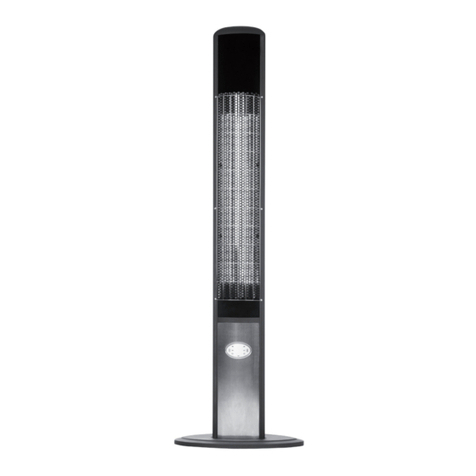
Firesense
Firesense 62233 manual
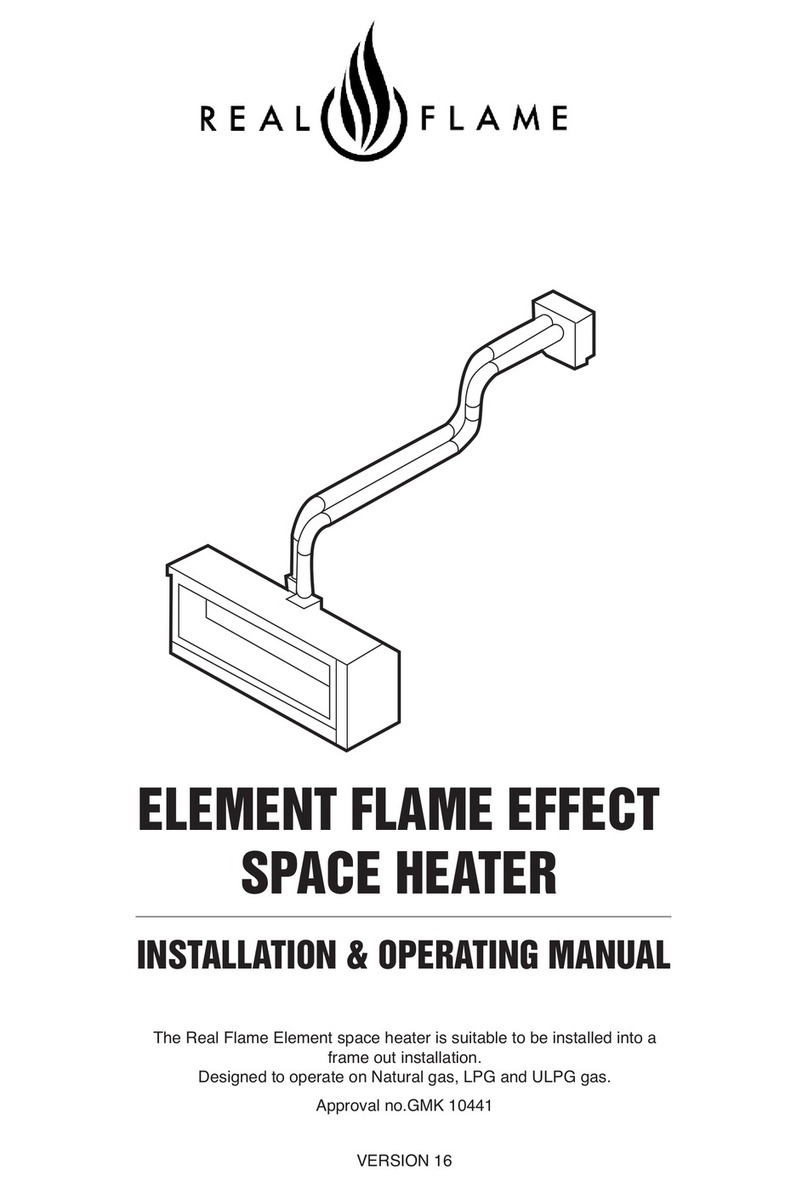
RealFlame
RealFlame ELEMENT 1200 Installation & operating manual

Universal Blue
Universal Blue UCBR9600-20 instruction manual
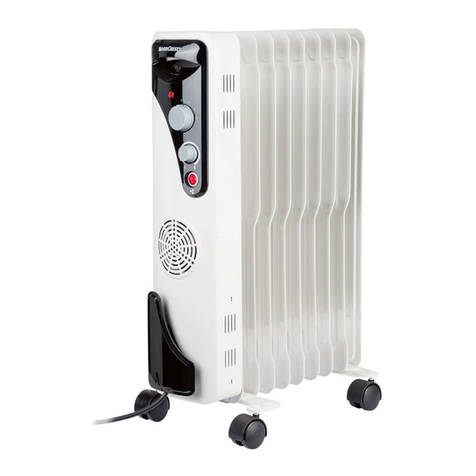
Silvercrest
Silvercrest SOR 2400 D2 Operation and safety notes
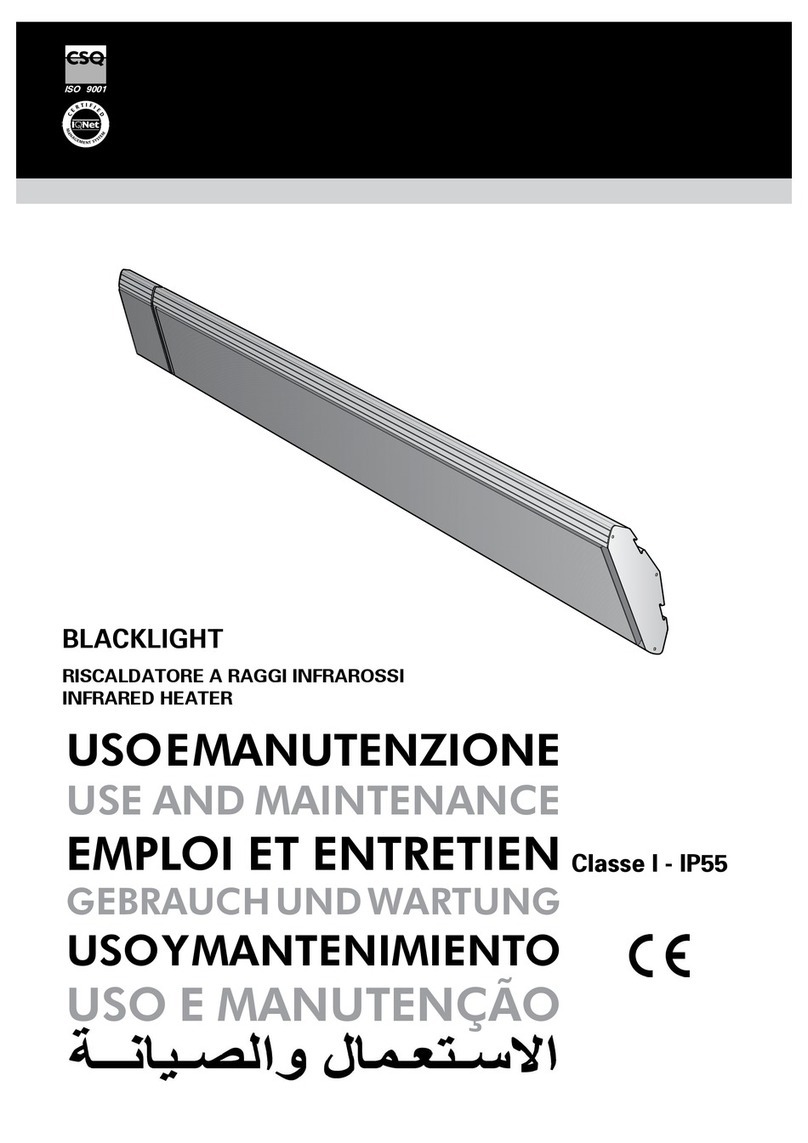
MO-EL
MO-EL BLACKLIGHT Series Use and maintenance

Procom
Procom MNSD300HGA OWNER'S OPERATION AND INSTALLATION MANUAL

Heatwagon
Heatwagon 1800 Installation and maintenance manual
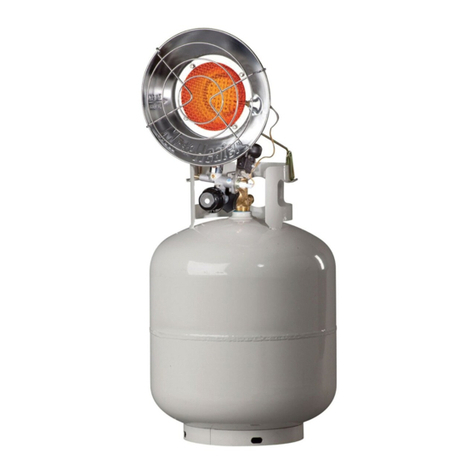
MrHeater
MrHeater MH15TS Operating instructions and owner's manual
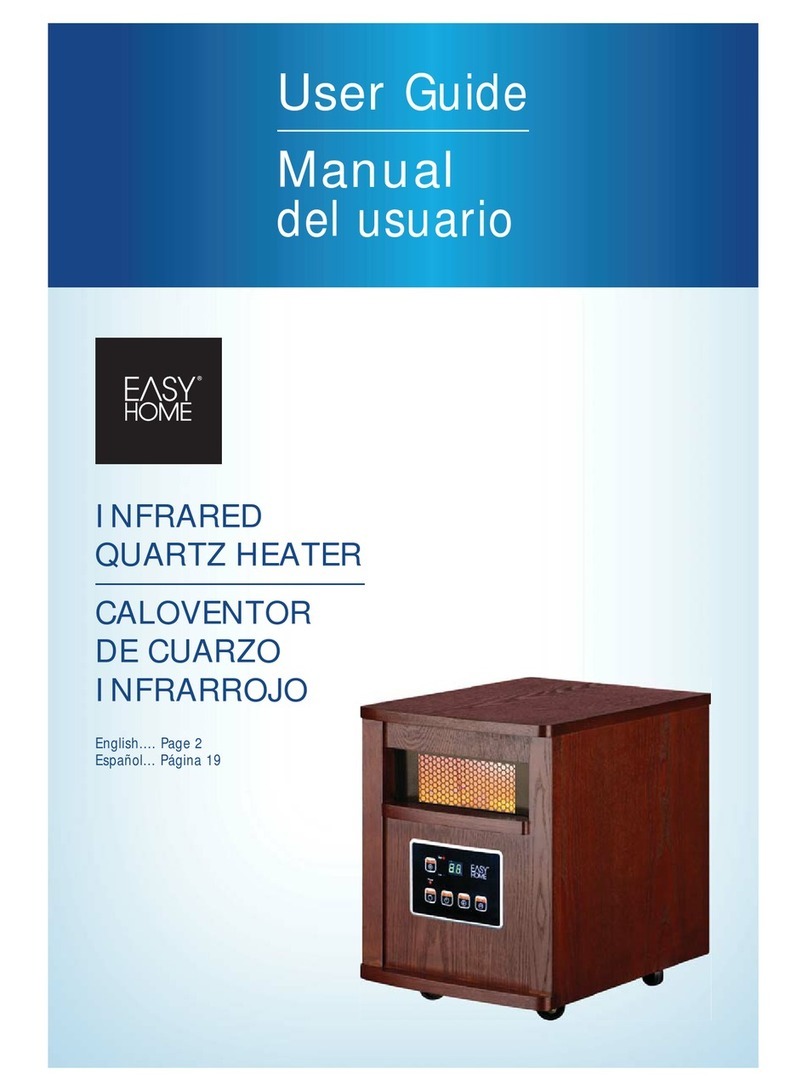
Easy@Home
Easy@Home EHQH15W user guide

New Air
New Air NOH32WBK00 owner's manual

Kero-Sun
Kero-Sun KBH-30 instruction manual
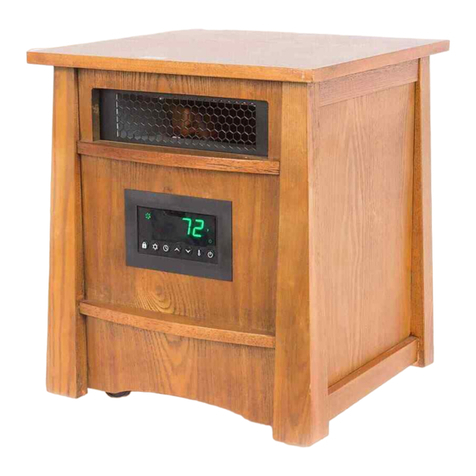
Life Smart
Life Smart LS-8WIQH-DB Owners installation and operating manual
